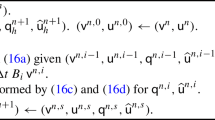Abstract
We develop a numerical solver for three-dimensional poroelastic wave propagation, based on a high-order discontinuous Galerkin (DG) method, with the Biot poroelastic wave equation formulated as a first order conservative velocity/strain hyperbolic system. To derive an upwind numerical flux, we find an exact solution to the Riemann problem; we also consider attenuation mechanisms both in Biot’s low- and high-frequency regimes. Using either a low-storage explicit or implicit–explicit (IMEX) Runge–Kutta scheme, according to the stiffness of the problem, we study the convergence properties of the proposed DG scheme and verify its numerical accuracy. In the Biot low frequency case, the wave can be highly dissipative for small permeabilities; here, numerical errors associated with the dissipation terms appear to dominate those arising from discretisation of the main hyperbolic system. We then implement the adjoint method for this formulation of Biot’s equation. In contrast with the usual second order formulation of the Biot equation, we are not dealing with a self-adjoint system but, with an appropriate inner product, the adjoint may be identified with a non-conservative velocity/stress formulation of the Biot equation. We derive dual fluxes for the adjoint and present a simple but illuminating example of the application of the adjoint method.






Similar content being viewed by others
References
Aki, K., Richards, P.G.: Quantitative Seismology. University Science Books, Sausalito (1980)
Bear, J.: Hydraulics of Groundwater. Dover, New York (1979)
Biot, M.A.: Theory of propagation of elastic waves in a fluid saturated porous solid. I. Low frequency range. J. Acoust. Soc. Am. 28(2), 168–178 (1956)
Biot, M.A.: Theory of propagation of elastic waves in a fluid saturated porous solid. II. Higher frequency range. J. Acoust. Soc. Am. 28(2), 179–191 (1956)
Biot, M.A.: Mechanics of deformation and acoustic propagation in porous media. J. Appl. Phys. 33(4), 1482–1498 (1962)
Biot, M.A., Willis, D.G.: The elastic coefficients of the theory of consolidation. J. Appl. Mech. 24, 594–601 (1957)
Carcione, J.M.: Wave Fields in Real Media: Wave Propagation in Anisotropic, Anelastic and Porous Media. Elsevier, Amsterdam (2015)
Carcione, J.M., Quiroga-Goode, G.: Some aspects of the physics and numerical modeling of Biot compressional waves. J. Comput. Acoust. 3, 261–280 (1995)
Carpenter, M.H., Kennedy, C.A.: Fourth-order 2N-storage Runge–Kutta schemes. Technical report, NASA-TM-109112 (1994)
Cavaglieri, D., Bewley, T.: Low-storage implicit/explicit Runge–Kutta schemes for the simulation of stiff high-dimensional ODE systems. J. Comput. Phys. 286, 172–193 (2015)
Diaz, J., Ezziani, A.: Analytical solution for wave propagation in stratified poroelastic medium. Part II: the 3D case. eprint in arXiv, https://arxiv.org/abs/0807.4067 (2008). http://www.spice-rtn.org/library/software/Gar6more3D
Dudley Ward, N.F., Eveson, S.P., Lähivaara, T.: A discontinuous Galerkin method for three-dimensional elastic and poroelastic wave propagation: forward and adjoint problems. eprint in arXiv, https://arxiv.org/abs/2001.09478 (2020)
Dudley Ward, N.F., Lähivaara, T., Eveson, S.: A discontinuous Galerkin method for poroelastic wave propagation: the two-dimensional case. J. Comput. Phys. 350, 690–727 (2017)
Fichtner, A.: Full Seismic Waveform Modelling and Inversion. Springer, New York (2011)
Fichtner, A., Bunge, H.-P., Igel, H.: The adjoint method in seismology I. Theory Phys. Earth Planet. Inter. 157, 86–104 (2006)
Hesthaven, J.S., Warburton, T.: Nodal Discontinuous Galerkin Methods: Algorithms, Analysis, and Applications. Springer, New York (2007)
Karypis, G., Kumar, V.: A fast and high quality multilevel scheme for partitioning irregular graphs. SIAM J. Sci. Comput. 20(1), 359–392 (1998)
Kennedy, C.A., Carpenter, M.H.: Additive Runge–Kutta schemes for convection-diffusion-reaction equations. Appl. Numer. Math. 44(1–2), 139–181 (2003)
Lähivaara, T., Dudley Ward, N.F., Huttunen, T., Koponen, J., Kaipio, J.P.: Estimation of aquifer dimensions from passive seismic signals with approximate wave propagation models. Inverse Probl. 30(1), 015003 (2014)
Lähivaara, T., Dudley Ward, N.F., Huttunen, T., Rawlinson, Z., Kaipio, J.P.: Estimation of aquifer dimensions from passive seismic signals in the presence of material and source uncertainties. Geophys. J. Int. 200, 1662–1675 (2015)
Lemoine, G.I., Yvonne Ou, M., LeVeque, R.J.: High-resolution finite volume modeling of wave propagation in orthotropic poroelastic media. SIAM J. Sci. Comput 35(1), B176–B206 (2013)
LeVeque, R.J.: Finite Volume Methods for Hyperbolic Problems. Cambridge University Press, Cambridge (2002)
Morency, C., Luo, Y., Tromp, J.: Finite-frequency kernels for wave propagation in porous media based upon adjoint methods. Geophys. J. Int. 179(2), 1148–1168 (2009)
Shukla, K., Chan, J., de Hoop, M.V., Jaiswal, P.: A weight-adjusted discontinuous Galerkin method for the poroelastic wave equation: penalty fluxes and micro-heterogeneities. J. Comput. Phys. 403 (2020)
Shukla, K., Hesthaven, J.S., Carcione, J.M., Ye, R., de la Puente, J., Jaiswal, P.: A nodal discontinuous Galerkin finite element method for the poroelastic wave equation. Comput. Geosci. (2018)
Tromp, J., Komatitsch, D., Liu, Q.: Spectral-element and adjoint methods in seismology. Commun. Comput. Phys. 3(1), 1–32 (2008)
Wilcox, L.C., Stadler, G., Bui-Thanh, T., Ghattas, O.: Discretely exact derivatives for hyperbolic PDE-constrained optimization problems discretized by the discontinuous Galerkin method. J. Sci. Comput. 63, 138–162 (2015)
Zhan, Q., Zhuang, M., Liu, Q.H.: A compact upwind flux with more physical insight for wave propagation in 3-d poroelastic media. IEEE Trans. Geosci. Remote Sens. 56(10), 5794–5801 (2018)
Zhan, Q., Zhuang, M., Mao, Y., Liu, Q.H.: Unified Riemann solution for multi-physics coupling: anisotropic poroelastic/elastic/fluid interfaces. J. Comput. Phys. 402 (2020)
Author information
Authors and Affiliations
Corresponding author
Additional information
Communicated by Tom Carroll.
In memoriam, W.K. Hayman, FRS.
Publisher's Note
Springer Nature remains neutral with regard to jurisdictional claims in published maps and institutional affiliations.
Rights and permissions
About this article
Cite this article
Dudley Ward, N., Eveson, S. & Lähivaara, T. A Discontinuous Galerkin Method for Three-Dimensional Poroelastic Wave Propagation: Forward and Adjoint Problems. Comput. Methods Funct. Theory 21, 737–777 (2021). https://doi.org/10.1007/s40315-021-00395-4
Received:
Revised:
Accepted:
Published:
Issue Date:
DOI: https://doi.org/10.1007/s40315-021-00395-4




